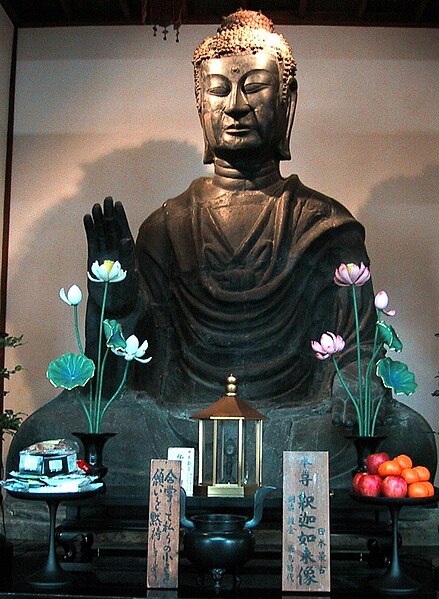Tori Busshi was a Japanese sculptor active in the late 6th and early 7th century. He was from the Kuratsukuri clan, and his full title was Shiba no Kuratsukuri-be no Obito Tori Busshi (司馬鞍作部首止利仏師); Busshi is a title meaning "the maker of Buddhist images". By the early 7th century, Tori Busshi had become the favorite sculptor of Soga no Umako and Prince Shōtoku. Such high-ranking patrons indicate that Tori was highly esteemed as an artist and not just an anonymous craftsman. Many extant Asuka period sculptures in gilt bronze are credited to Tori and his workshop. The artist's work epitomizes Japanese sculpture during the era, with its solid, geometric figures in front-oriented, characteristic poses.
The Shaka image of Asukadera, sculpted by Tori Busshi in 606
Shaka Triad in Hōryūji, 623
The Asuka period was a period in the history of Japan lasting from 538 to 710, although its beginning could be said to overlap with the preceding Kofun period. The Yamato polity evolved greatly during the Asuka period, which is named after the Asuka region, about 25 km (16 mi) south of the modern city of Nara.
The Daibutsu at the Asuka-dera in Asuka, the oldest known statue of the Buddha in Japan with an exact known date of manufacture, 609 AD; the statue was made by Kuratsukuri-no-Tori, son of a Korean immigrant.
A stone foundation section of the Mount Shioji Ōnojō Castle Ruins, where construction began in 665
A wall mural depicting ladies, from the west wall of the Takamatsuzuka Tomb, late 7th century, Asuka period
A dragon-head pitcher with Pegasus pattern incised, gilded bronze with silver, Asuka period, 7th century, former Horyu-ji Temple treasures, Tokyo National Museum





